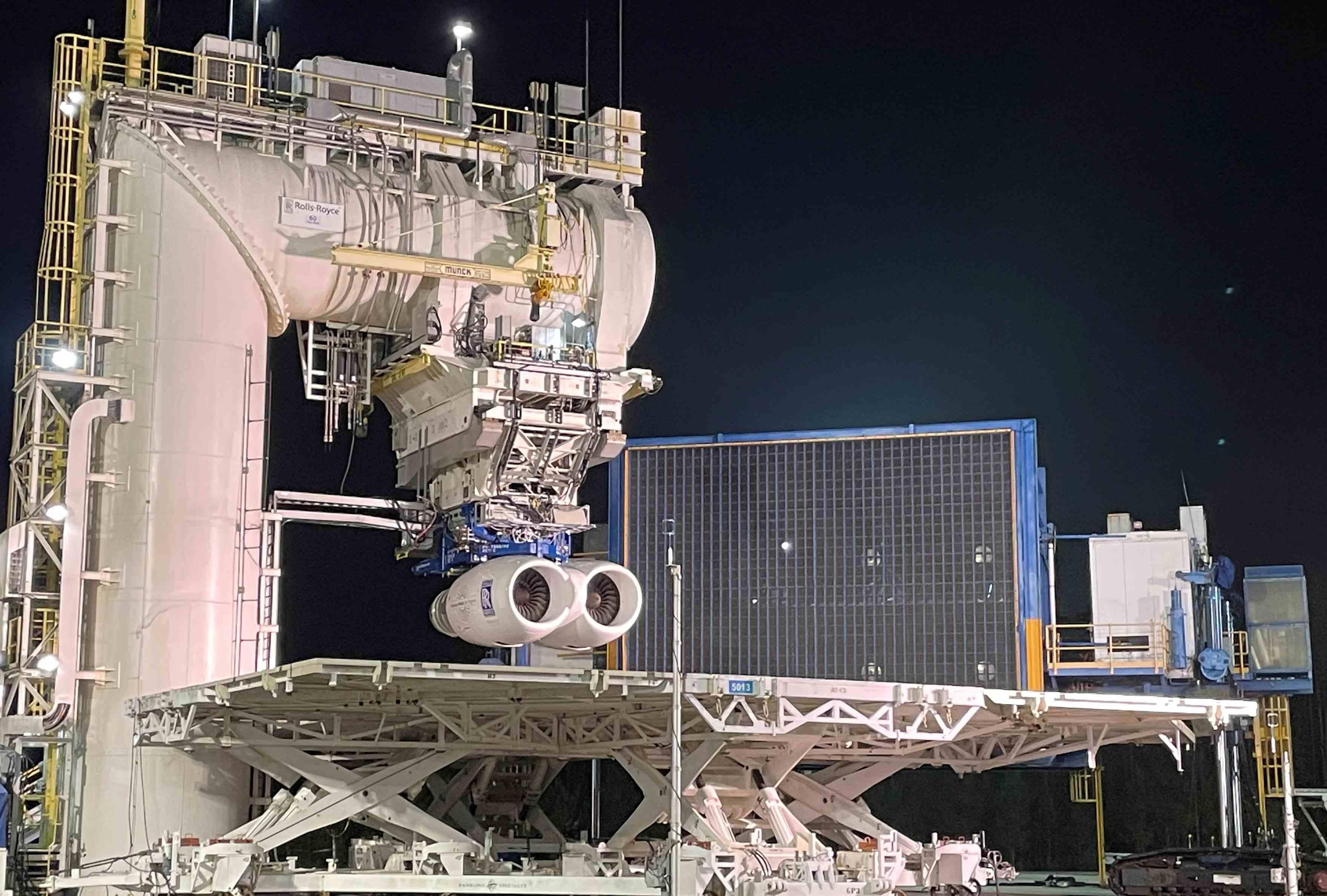
Dual-podded F130 turbofans pictured at Rolls-Royce's facility at NASA Stennis Space Center.
Rolls-Royce is poised to begin a third phase of ground tests with a pair of dual-podded F130 turbofans for the U.S. Air Force’s B-52J re-engining program and is on track to undertake the critical design review (CDR) for the production version early next year.
The next series of tests at Rolls-Royce’s facility at NASA Stennis Space Center in Mississippi will evaluate the engines fitted with acoustic liners in the inlet, a feature that has been added to the F130 nacelle following the results of a second test phase that was completed in late July.
Forming part of an extended program to replace the B-52’s aging Pratt & Whitney TF33 powerplants with the F130, Rolls-Royce is testing a 17,000-lb.-thrust military derivative of the BR725 variant that powers the Gulfstream G650 business jet. The program, which will cover more than 600 engines, was awarded to Rolls-Royce in September 2021.
“All of the BR700 family of engines that the F130 is derived from have an acoustic treatment on the inlet, so it really just reinforced the modeling that we had done and that Boeing had done leading up to the test,” said Scott Ames, Rolls-Royce’s program director for the B-52 and F130. The inlet liner, which is perforated with small holes, dissipates incident acoustic energy from the engine and reduces noise—particularly from the fan.
“We suspected we needed one for this just because of the physics of the fan in that configuration. But as we agreed with the Air Force and Boeing, we were going to test it without and see if the configuration with the Boeing inlet mandated it or not,” Ames said.
In the meantime, Rolls-Royce is “right on schedule” to conduct a CDR in the first quarter of 2024, he adds. The engine maker is taking a different tack to the approach for the earlier preliminary design review by eschewing the conventional update process in favor of periodic deep dives with Air Force propulsion specialists at which the analysis of test results are discussed.
“That’s proven to be really beneficial,” Ames said. “You can have the right conversations at the right detailed level to work through. So we can answer whatever questions the Air Force may have or [show] additional evidence or detail they might require to make sure that we’re meeting all the requirements. We held one of those at Wright Patterson AFB, Ohio, last month and we’ll be having another one here in October before we kind of close out the year to make sure we’re right on track for that formal CDR.”
Rolls-Royce is also modifying a pair of BR725s into F130s for the next series of ground tests at its Indianapolis assembly site, where full-scale assembly of production standard engines will get underway later this decade for the B-52J. The first of the pair—ground test engine number three—will be the first to run with control software developed for the F130 and will run in the second quarter of 2024.
“We’ll be running that engine in our test facilities here in Indianapolis and then that engine will then proceed to the Arnold Engineering Development Complex (AEDC) in Tullahoma, Tennessee, in the fourth quarter of 2024 for altitude and freezing fog tests. So, it’s going to be a busy year next year for engine three,” Ames said.
Ground test engine four, destined for durability work, will run in Indianapolis in 2025. Two lots of flight-test engines will follow, with initial preparations for the first batch starting late next year. The second batch will undergo work in parallel, Ames said. “Those engines will start as BR725s and we’ll remake them into F130s with all the changes we’re doing to make sure it fits into the B-52. So, a lot going on in our assembly facility, which is doubling as a development facility for us right now.”
Flight tests will be undertaken on a pair of B-52s sometime following delivery to the Air Force in 2025. Although no specific timetable has been released by the service, Ames said “we certainly want to see them on the aircraft and flying around as soon as possible.”





